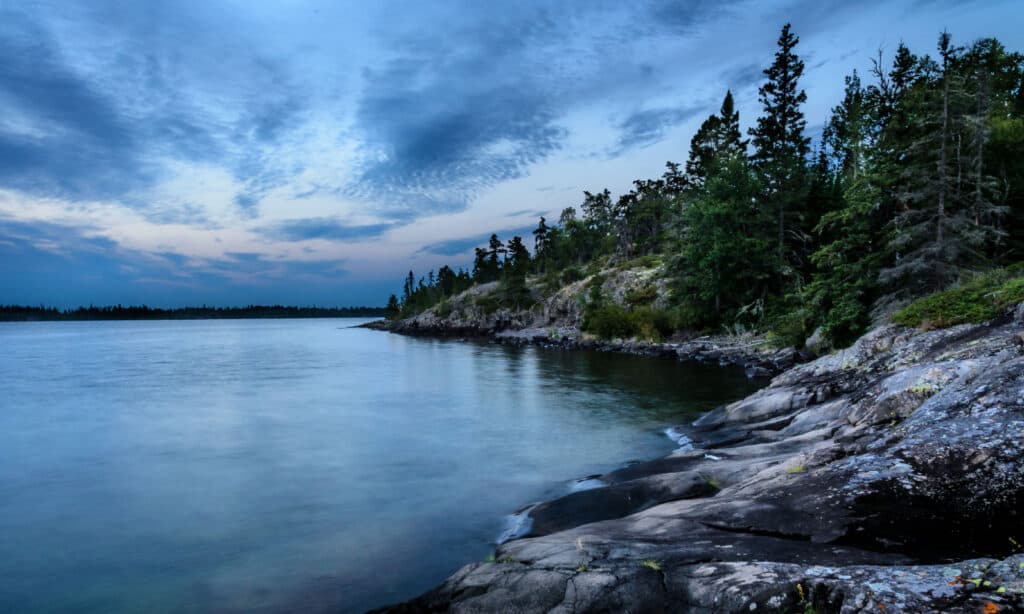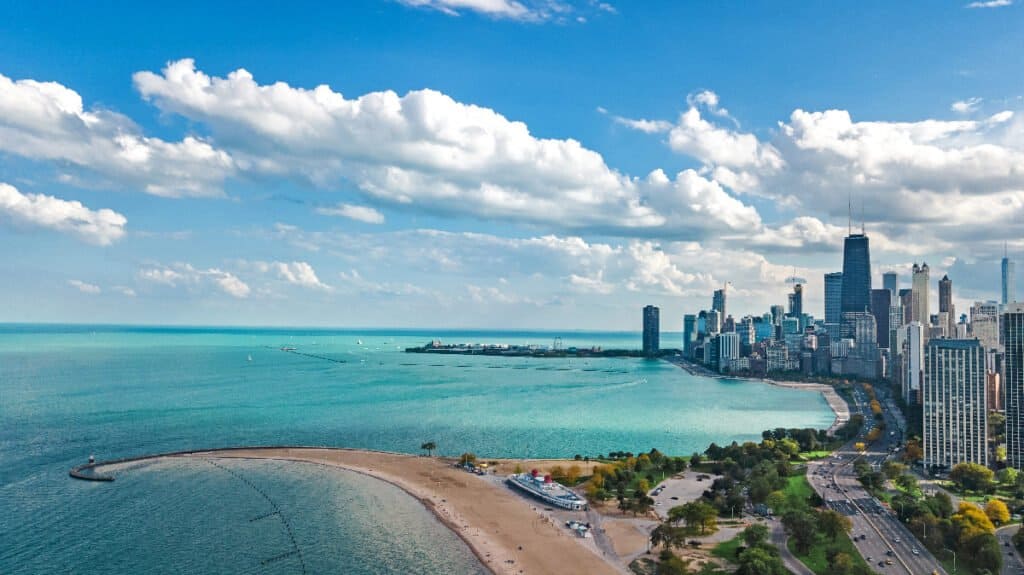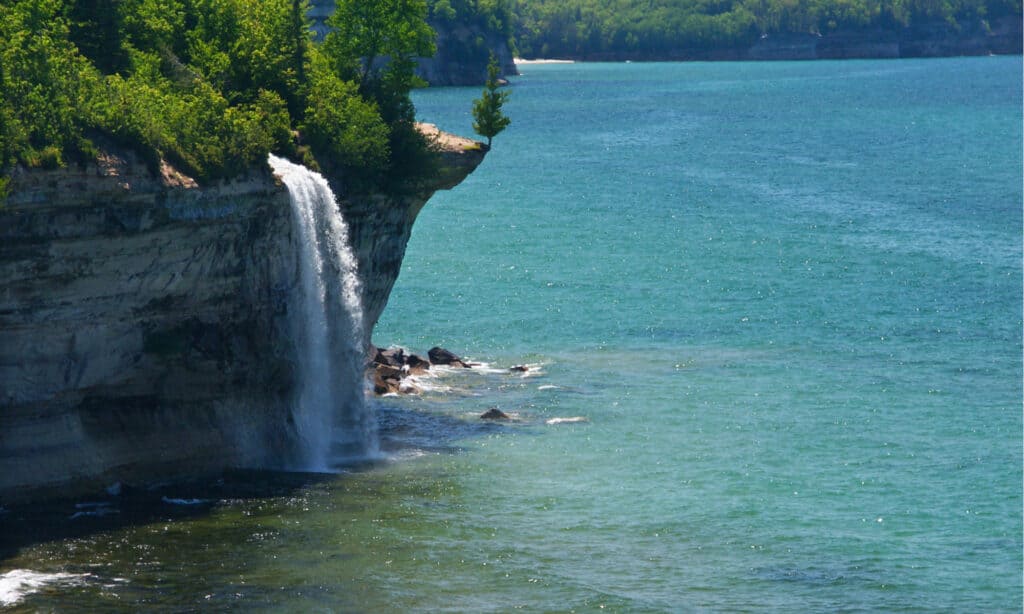The Great Lakes of North America are five massive lakes located in Canada and the United States. Although they are freshwater lakes, the Great Lakes are known for having certain sea-like qualities due to their size, depth, currents, and sustained winds in their locale. Today, we’re going to examine these massive lakes and show you which is the largest Great Lake of them all.
By the time we’re done, you’ll know which lake is the largest, which one is the deepest, and why two of them are sometimes considered one. Let’s start our deep dive into the Great Lakes with a brief overview of them.
What Are the Five Great Lakes?

Lake Superior is a massive freshwater body.
©Sorayot Chinkanjanarot/Shutterstock.com
The five Great Lakes are:
- Lake Superior: the farthest west lake that is bordered by Ontario in Canada and Minnesota, and Michigan in the United States.
- Lake Michigan: the only one of the Great Lakes located entirely within the U.S., and it’s connected to Lake Huron at the Straits of Mackinac.
- Lake Huron: the lake is bordered by Michigan to its west and Ontario, Canada to its north and west.
- Lake Erie: the smallest of the Great Lakes, but it also has major cities on its shores including Cleveland, Detroit, Buffalo, and Toledo.
- Lake Ontario: the farthest east of all the Great Lakes, the water from this lake runs into the St. Lawrence River and out to the Atlantic Ocean.
The Great Lakes have been a source of food, transportation, and freshwater for those living along their banks for many years. They are so vast and complex that some people consider them inland seas even though they don’t meet all the criteria of them.
Now that we know a little about the Great Lakes, let’s take a look at how they measure up.
Which Is the Largest Great Lake?

Lake Superior is often considered the largest freshwater lake in the world.
©iStock.com/Posnov
Lake Superior is the largest Great Lake. This lake measures about 31,700 square miles in surface area, making it larger than all the other Great Lakes. In fact, it’s the largest freshwater lake in the entire world by surface area alone. Lake Superior holds 10 percent of all the world’s freshwater. The only other lake that is larger than Lake Superior in the world is the Caspian Sea.
Now that we know that Lake Superior is the largest Great Lake, we should also take some time to discover the size of the other Great Lakes.
| Lake | Size |
|---|---|
| Lake Superior | 31,700 square miles |
| Lake Huron | 23,007 square miles |
| Lake Michigan | 22,404 square miles |
| Lake Erie | 9,910 square miles |
| Lake Ontario | 7,340 square miles |
As you can see, Lake Ontario is the smallest of all the lakes and Lake Erie is a bit larger. However, the other two lakes, Lake Huron and Lake Michigan are interesting cases. Technically, they could be considered the biggest of the Great Lakes by surface area. Let’s take a closer look at how that would work.
What Other Lakes Could Be Considered the Largest?

Lake Michigan and Lake Huron are connected, and they can be considered the largest of the Great Lakes.
©JaySi/Shutterstock.com
Technically speaking, Lake Michigan and Lake Huron are a single body of water and not two different ones. The two lakes are joined by the Straits of Mackinac, waterways measuring about 5 miles wide and roughly 120 feet deep.
On a hydrological level, Lake Michigan and Lake Huron are one body since they occur at the same elevation, the water level in the lakes equalizes through their flow at the Straits of Mackinac. Furthermore, the two bodies are not connected by streams and rivers like other lakes. They are connected by relatively narrow Straits of Mackinac waterway. Thus, the water level between them stays the same.
For all these reasons, the two lakes are often considered Lake Michigan-Huron (or Huron-Michigan) when discussed in scientific literature. The changes in one lake, such as the water level, are seen in the other. Their interconnectivity would make Lake Michigan-Huron the largest Great Lake at 45,400 square miles in size.
Yet, you should not look for the two bodies of water to be combined into one entity in any legally binding way or on maps. After all, Lake Michigan is the only one of the Great Lakes to exist entirely within the United States. Lake Huron forms a boundary area between the U.S. and Canada. Calling them one entity could make for some interesting legal issues.
Which is the Deepest of the Five?
Now that we know about the largest Great Lake and the complication of that designation, let’s consider the deepest. Lake Superior is the deepest Great Lake. This lake has an average depth of about 500 feet, and it has a maximum depth of 1,333ft.
Lake Michigan is the second-deepest Great Lake with a maximum depth of 923 feet, making it far shallower than Lake Superior.
Which Great Lake Has the Highest Volume?

Spray Falls plunges into Lake Superior.
©Jason Patrick Ross/Shutterstock.com
Given that it has the largest surface area and greatest depth, Lake Superior also has the highest volume. Lake Superior contains 2,900 cubic miles of water. That is more water than all the other lakes combined. Lake Michigan has the second-largest water volume of all the Great Lakes with 1,180 cubic miles.
The Great Lakes are massive bodies of water that have served economical purposes and continue to support immense biodiversity. Millions of tons of cargo are moved across the lakes and millions of people flock to the shores of the lakes each year for recreation.
The recreational fishing and boating industries generate billions of dollars each year. However, the lakes are facing challenges in the form of pollution and invasive species.
Lake Superior is the largest, deepest, and most voluminous of all the lakes if the five-lake model is followed. However, if Lake Michigan and Huron are considered one large lake as Lake Michigan-Huron, as they probably should be, then that massive body of water is the largest Great Lake.
Thank you for reading! Have some feedback for us? Contact the AZ Animals editorial team.








